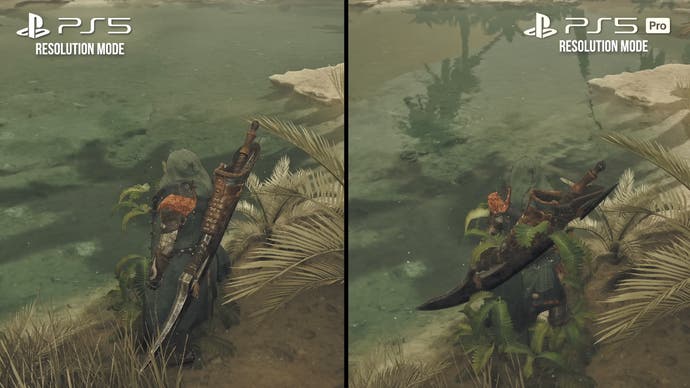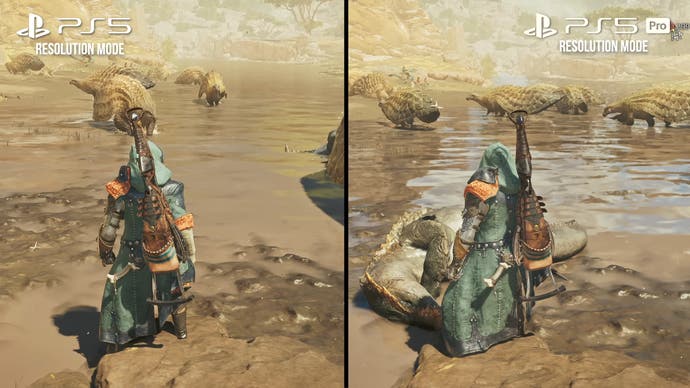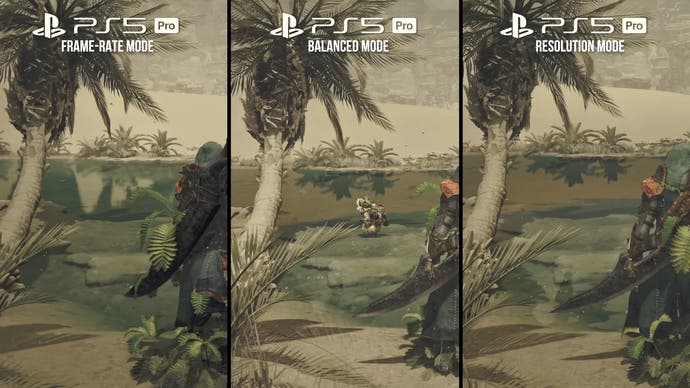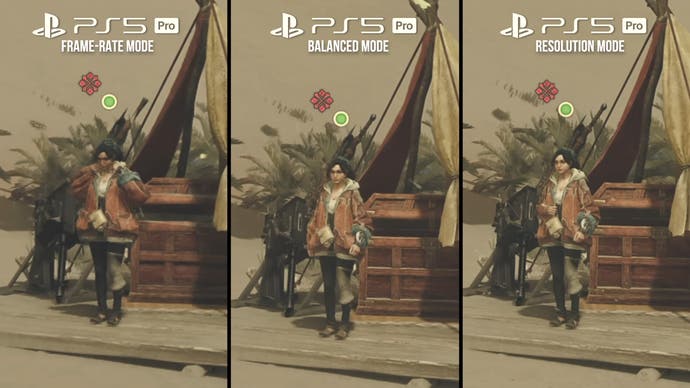Monster Hunter Wilds is an effective trying recreation, however its console iterations aren’t good. The bottom PlayStation 5 and Xbox Collection X pack loads of visible modes, however endure from substantial picture high quality and efficiency woes whereas missing the PC model’s higher-end settings. Sony’s PS5 Professional, although, ought to carry an antidote for these afflictions – with PSSR and ray tracing within the combine. Does Sony’s enhanced machine comprehensively handle Wilds’ console failings then, or is there a deeper root trigger?
The sport’s 60fps frame-rate mode is essentially the most thrilling choice on PS5 Professional for me, as a result of the turnout on the bottom PS5 wasn’t nice. The sport suffered from extreme aliasing and picture breakup, a consequence of counting on a fairly weak anti-aliasing resolution with a crude mixture of spatial upscaling and sharpening to make it look extra refined on a 4K set. Internally, we have been taking a look at resolutions from about 720p to 1080p with dynamic decision scaling, however the system lacked the customary temporal upsampling course of that may make a low-resolution render look respectable on high-resolution shows.
PS5 Professional brings that upsampling to bear right here, with an implementation of Sony’s PSSR upscaler – and the outcomes are a lot improved, even in stills. The Professional is far more temporally steady relative to the bottom console, with out the ugly stair-stepping artefacts that we noticed on PS5. In scenes with loads of dense geometry, the Professional resolves a a lot cleaner picture that holds up effectively. Oddly, the bottom PS5 really has an edge by way of total picture sharpness, because of its post-process sharpening, however the fundamentals of the picture are a lot stronger on Professional.
After we really transfer by means of the sport world, although, the variations are extra stark. Right here, the PS5 actually struggles to resolve something approaching a clear picture, with fixed and shifting stair-stepping geometry and flickering foliage. The Professional is much extra pristine as compared, resolving a clean (if smooth) picture.
When it comes to the uncooked rendering metrics, we’re taking a look at a 1080p inside decision on PS5 Professional with PSSR. Dynamic decision scaling is feasible, however I did not spot it in my testing. It is also fascinating that there are not any clear indicators of upscaling right here, as you’d usually anticipate PSSR to resolve to a 4K picture – however right here it appears to be like fairly smooth and 1080p-like. That leads me to counsel it is likely to be a use case considerably analagous to “DLAA” on Nvidia PC graphics playing cards – utilizing tremendous decision for anti-aliasing solely. It isn’t too dangerous compared to the bottom console, however a methods away from the 4K 60fps dream of the PS5 Professional.
The Professional additionally does a greater job of hitting a steady 60fps than the bottom console. It is nonetheless not an ideal 60, however dips are rare and never very impactful to gameplay compared to PS5. Unlocking the frame-rate with a 120Hz show permits for larger frame-rates, usually 60-80fps. If in case you have VRR on, it is price attempting, although I might most likely nonetheless fairly go for the 60fps cap.
Sadly, in frame-rate mode we nonetheless get the same old RE Engine display area reflections (SSR) on our bodies of water, which appears to be like artefact-ridden and liable to apparent occlusion points. That’s solved within the decision mode on PS5 Professional, which makes use of extra correct RT reflections that will let you see components which might be utterly off-screen. The SSR appears to be like low-res and muddy by comparability, struggling to create convincing-looking reflections.
The RT reflections do have sure flaws, although. They’ll endure from fairly a little bit of breakup whenever you transfer by means of a scene, with less-than-ideal denoising and clearly restricted decision. You’ll be able to discover substantial pop-in within the reflections as you progress ahead, which is usually a bit distracting. The volumetric lighting within the scene is not actually approximated successfully inside the ray tracing both, which might make the reflections look a bit incorrect at instances. Nonetheless, I feel it is a main enchancment over the SSR on PS5, and it represents a transparent visible win for the Professional console.
Past any RT considerations, picture high quality can also be usually higher on Professional. PSSR cleans up flickering foliage higher than the TAA in use on PS5, particularly throughout motion. Aliasing is usually much less of a priority as effectively, with a smoother, extra refined presentation of artwork property. The picture is barely softer than the image on the bottom console, however I might give the nod to Professional total – and it appears to be like sharp sufficient from a traditional viewing distance.


When it comes to inside decision, the uncooked numbers from Capcom counsel a 1728p pixel depend, although my very own counts are a bit larger – usually 1944p – with dynamic decision inflicting some variation. Efficiency is usually advantageous sufficient, with a 30fps studying by means of most content material, however there are extra frequent frame-drops than on the bottom PS5 in content material like quick traversal or demanding fight encounters. Unlocked, efficiency between about 30fps and 45fps is typical.
Lastly, there’s the balanced mode. As its identify implies, this strikes a center floor between the opposite two mode choices, with a 40fps frame-rate goal. New right here is the introduction of ray traced reflections, similar to the decision mode, that are a pleasant bonus. Picture high quality once more is superior to PS5, with a cleaner look total and maybe only a contact much less sharpness. PSSR does a more practical job of addressing stair-stepping, shimmering, and different visible gremlins from the bottom console.
Capcom reviews this mode as utilizing a 1404p inside decision, which aligns with my very own testing, although DRS can take it decrease or quite a bit larger relying on the circumstances. Efficiency is once more OK, however with small dips with the same old quick traversal or fight triggers. It is a fairly related turnout to the PS5’s balanced mode, which has related points. Unlocked, the sport actually likes to remain pegged near 40fps, which is probably an indication that the DRS system continues to be working arduous throughout unlocked play.
As a last be aware, similar to PS5, 120Hz output with VRR does not interact LFC with this title for the balanced or decision modes, so it feels choppier than it ought to, particularly when uncapped. Solely the frame-rate mode can actually get the total profit from VRR.


If we stack the three key modes right here in opposition to one another, the obvious distinction comes all the way down to picture high quality, with a smooth frame-rate mode and more and more sharper and detailed outcomes at balanced and determination. Not one of the modes endure from extreme edge aliasing or flicker, however the two lower-performing modes do maintain up higher on a 4K pixel grid.
The opposite apparent concession lies in reflections on our bodies of water, the place the decision and balanced modes take pleasure in similar-looking RT reflections, and the frame-rate mode is left to accept SSR as an alternative. Some areas are fairly arid and do not actually see a lot profit, whereas others have extra intensive water options and do look a lot better with the RT reflections. Outdoors of these two areas, the identical little tweaks current between the PS5 modes are additionally current right here. Volumetric lighting high quality is worse within the frame-rate mode, LODs are pulled in and GI high quality takes a small hit as effectively. Typically although, the important thing factors of differentiation are these picture high quality and reflection modifications.
General, I just like the frame-rate mode now, because the comparatively weak movement blur requires the next frame-rate for clean outcomes. Balanced mode can also be a robust contender, with a noticeable enhance to sharpness whereas nonetheless feeling OK in efficiency phrases. Decision mode does not provide a large enough enhance in readability to make the degradation to responsiveness really feel worthwhile. It would be simpler to advocate these latter two modes if Capcom fixes the LFC problem affecting them.
Finally, I feel Monster Hunter Wilds’ PS5 Professional boosts are very welcome. The sport appears to be like quite a bit higher than the bottom console, with visuals that get each picture high quality and have degree enhancements. If I had any critique particularly, it is that Wilds is sort of a heavy title usually, so the Professional boosts do not actually deliver it as much as the identical degree as different comparable titles. In its finest moments, the Professional can elevate PS5 software program to have credible 4K60 imagery or transformative ray tracing, and that is not the case right here. As an alternative, we get picture high quality and efficiency pairings that loads of gamers would have moderately anticipated from the bottom PS5, with a 1080p60-like frame-rate mode and two decrease efficiency modes with higher picture high quality and restricted RT.



